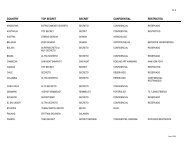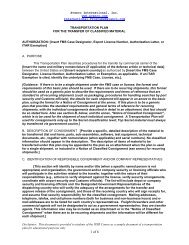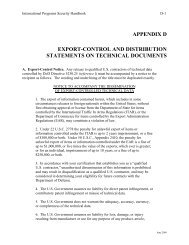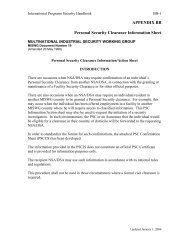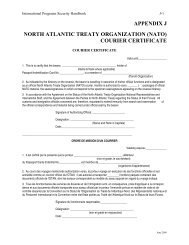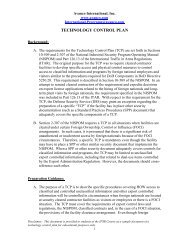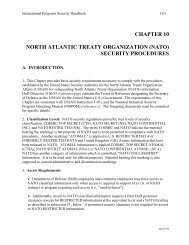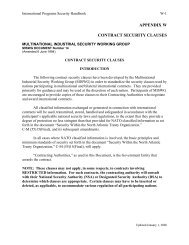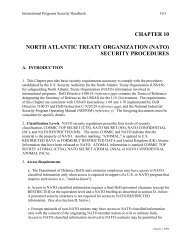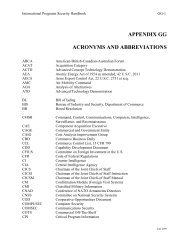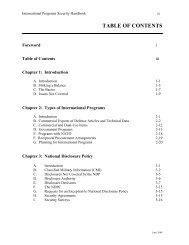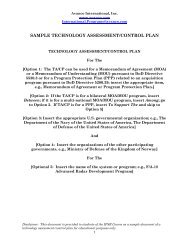Chapter 9 - Avanco International, Inc.
Chapter 9 - Avanco International, Inc.
Chapter 9 - Avanco International, Inc.
You also want an ePaper? Increase the reach of your titles
YUMPU automatically turns print PDFs into web optimized ePapers that Google loves.
<strong>International</strong> Programs Security Handbook 9-1<br />
CHAPTER 9<br />
THE MULTINATIONAL INDUSTRIAL<br />
SECURITY WORKING GROUP (MISWG)<br />
A. INTRODUCTION.<br />
1. The origin of the Multinational Industrial Security Working Group, or MISWG (mis-wig),<br />
can be traced to mid-1985. At that time, the United States (U.S.) Department of Defense (DoD)<br />
under new legislation designed to solicit cooperation with the North Atlantic Treaty Organization<br />
(NATO) allies in research and development efforts leading to the production of interoperable<br />
weapons systems, had begun to negotiate agreements for cooperative arms programs with those<br />
allies. The negotiators of the agreements for these early programs soon began to complain that<br />
the information and industrial security requirements of the various governments that were to be<br />
participants in the programs were not compatible. This lack of compatibility had become an<br />
impediment to international arms cooperation.<br />
2. The Deputy Under Secretary of Defense for Security Policy (DUSD(SP)) in 1985 was<br />
responsible for DoD information and industrial security support for international programs.<br />
(Note: The ODUSD(SP) international functions were subsequently transferred to the Office of<br />
the Deputy Under Secretary of Defense for Policy Integration and Chief of Staff (ODUSD (PI &<br />
CoS)). The domestic industrial security functions were transferred to Office of the Deputy<br />
Under Secretary of Defense for Counterintelligence and Security.) The DUSD(SP) instructed his<br />
Director for <strong>International</strong> Security Programs to contact his counterparts in those NATO countries<br />
that typically participated in international cooperative arms programs and develop a means to<br />
reconcile the security issues. Because bilateral German – U.S. security discussions were already<br />
scheduled at the time, the issue was discussed initially with the Director for Industrial Security<br />
from the German Federal Ministry of Economics (FMOE). The German Director agreed that<br />
incompatible security requirements among governments participating in the cooperative arms<br />
programs were becoming a problem, and procedures should be developed to apply standard<br />
security procedures to the programs. Both officials agreed that their counterparts in other NATO<br />
countries should be contacted to solicit their support of an initiative to solve the security issue.<br />
Consequently, they sent a letter signed by the DUSD(SP) and his counterpart in the FMOE, the<br />
Deputy Under Secretary of Economics, to their counterparts in the other NATO countries,<br />
suggesting that they all meet in Bonn to discuss the issue and seek a solution. They also<br />
personally contacted their counterparts to alert them to the initiative. All countries that were<br />
contacted expressed an interest in an initiative.<br />
3. Later in 1985, the German Federal Ministry of Economics hosted a meeting in Bonn of<br />
industrial security officials from all of the NATO countries, less Iceland. (Iceland declined,<br />
because it was not participating in the cooperative arms programs.) The German, United<br />
April 2010
<strong>International</strong> Programs Security Handbook 9-2<br />
Kingdom (UK), and U. S. representatives proposed the establishment of a working group which<br />
would review each country’s security procedures, determine the extent of any differences, and<br />
make recommendations for standard procedures. However, the German and Dutch<br />
representatives raised two questions: 1) Was the NATO Security Committee the appropriate<br />
forum in which to discuss the initiative?; and, 2) Was the group to be an officially constituted<br />
group or an ad hoc group? It was agreed that the NATO Security Committee should not be<br />
involved because the principal purpose of the initiative would be to address security issues for<br />
non-NATO cooperative programs among NATO countries, and possibly other countries. It was<br />
decided that the representatives would pursue the question of the status of the group with other<br />
officials within their respective governments. The Belgian representative agreed to host another<br />
meeting to discuss the results.<br />
4. The Belgium meeting was hosted at the facility of the European F-16 Production Group<br />
outside of Brussels in early 1986. Each country’s representative presented a briefing on<br />
industrial security requirements, and differences were noted. When the discussion turned to the<br />
status of the group, the French delegation did not favor the establishment of a formal, legally<br />
constituted group, and recommended that it operate under an ad hoc arrangement. The other<br />
representatives agreed. It was decided that the group would be limited to NATO member<br />
countries, a position that was later changed (see below). The name Multinational Industrial<br />
Security Cooperation Working Group was also adopted. The name was shortened at a<br />
subsequent meeting, hosted in the UK, to Multinational Industrial Security Working Group,<br />
abbreviated MISWG. A standard emblem for the MISWG was developed by the Netherlands in<br />
1993.<br />
5. These decisions raised another question – how to ensure that procedures developed by the<br />
group were used in cooperative programs. The establishment of the Senior Security Officials<br />
answered this question. The National Security Authorities (NSAs) (i.e., those officials<br />
recognized in NATO security regulations) or senior officials in each country who were<br />
responsible for international industrial security matters (Designated Security Authorities<br />
(DSAs)), would represent their countries at Forum meetings. The Senior Officials would meet<br />
approximately annually. They would approve any study initiatives that were proposed by the<br />
working group and approve any procedures that resulted from the initiatives. This would be<br />
accomplished in a set of minutes in which the signatories would “endeavor to ensure” that the<br />
procedures recommended by the group would be applied to cooperative programs.<br />
6. It was also decided that because the MISWG is an ad hoc group, it would not be necessary for<br />
each member country to subscribe to recommended procedures in order for them to be adopted.<br />
Those countries that desired to use the procedures could sign the minutes reflecting their<br />
agreement to use them; any country that did not desire to use them would not sign the minutes<br />
and not be obligated to use them. In fact, all of the documents were eventually accepted by all of<br />
the countries. The Seniors Forum continued to meet until November 1998 when it was decided<br />
that, since the Seniors were often participating in the working group meetings, the groups would<br />
be combined. Acceptance of the Working Group minutes by the participants was considered<br />
intent by the nations to use the procedures in cooperative programs.<br />
April 2010
<strong>International</strong> Programs Security Handbook 9-3<br />
7. Initially, MISWG member countries were encouraged to consult with their program<br />
management officials and defense contractors to develop recommendations for procedures to be<br />
analyzed and standardized by the member countries. The current MISWG documents number 1<br />
(Hand Carriage Procedures) and number 7 (<strong>International</strong> Visits) resulted from that initial effort.<br />
Document number 2 contained the original procedures for visits, but these procedures proved to<br />
be impractical. Document number 2 was cancelled and new procedures were published as<br />
document number 7. Subsequent documents addressed other procedures for industrial security.<br />
8. The MISWG initially met at least twice a year, particularly when the first 20 MISWG<br />
documents were being developed. The MISWG now usually meets at least annually. The<br />
members are afforded the opportunity to meet face-to-face with their counterparts from other<br />
countries and discuss current security issues that would be difficult to discuss by mail, the<br />
telephone, or by e-mail. Many participants have noted that by knowing their counterparts on a<br />
personal basis, and by meeting with them face-to-face, many problems that might otherwise have<br />
been impediments to cooperation have been solved. The MISWG also may designate sub-groups<br />
to analyze and prepare recommendations on a particular issue. With the advent of automated<br />
information systems, the MISWG participants are able to conduct a lot of business over the<br />
Internet.<br />
9. Although the MISWG was established originally to standardize security procedures for non-<br />
NATO cooperative arms programs involving NATO countries, other countries have asked to use<br />
the MISWG procedures in their cooperative arms programs. As a result, the procedures were<br />
made available to many other countries, and are now posted on the Internet for public use. The<br />
procedures also have been used by defense contractors in some countries (e.g., the UK and the<br />
United States) to apply standard procedures for commercial contracts. More recently, the NATO<br />
Security Committee incorporated many MISWG procedures in the NATO security regulation.<br />
Many NATO countries have adopted MISWG procedures as their national procedures.<br />
10. Membership in the MISWG originally was limited to NATO member countries; however,<br />
the idea of inviting non-NATO countries to become members was discussed at several meetings.<br />
Major concerns expressed by some countries were that non-NATO countries might not have the<br />
same objectives and motivation as the NATO countries, and with the addition of new members<br />
the group might become too large to remain effective. However, in 1999 at the meeting in<br />
Madrid, Spain the original MISWG member countries agreed to invite Sweden into the group.<br />
Austria and Switzerland were invited at the meeting in Budapest, Hungary in 2000, and Finland<br />
at the meeting in Switzerland in 2005, bringing the total of participant countries to twenty-nine.<br />
These non-NATO countries were sponsored by NATO countries whose companies participated<br />
in industrial arrangements with companies in the other countries. The Scope of Operations of the<br />
MISWG was amended at the meeting in The Hague, the Netherlands in 2001 to describe criteria<br />
and procedures under which non-NATO countries might be invited into the MISWG in the<br />
future. At that time, the term referring to countries participating in the MISWG was changed<br />
from “Member” to “Participant.”<br />
11. Finally, in addition to its efforts to standardize security procedures for cooperative programs,<br />
the MISWG also conducted briefing sessions related to security and export control for the socalled<br />
“Partnership for Peace” countries of Central and Eastern Europe which aspired to join<br />
April 2010
<strong>International</strong> Programs Security Handbook 9-4<br />
NATO. These sessions, which were held at the Marshall Center in Germany in October 1994<br />
and in Trencin, Slovakia in September 1996 helped to establish MISWG procedures in those<br />
countries’ developing industrial security programs.<br />
B. PROGRAM DOCUMENTS.<br />
The MISWG documents are described in the following paragraphs. Some of the documents are<br />
procedural in nature; others contain language that is to be placed in international agreements. It<br />
is important to note that each government that is a party to an agreement or contract, or that has<br />
legal jurisdiction over information involved in the agreement or contract, will have to agree to<br />
the procedures. Therefore, they must participate in the preparation of the of program or project<br />
documents that are based on the procedures. This is particularly important with respect to the<br />
Program/Project Security Instruction, or PSI, (Document #5). The documents are guides; they<br />
should not be specifically referenced in the documents that support a specific program or<br />
contract. Each document is to be used to tailor security procedures that implement the security<br />
requirements of agreements and contracts, or as required by a Technology Assessment/Control<br />
Plan (TA/CP) or PSI. In some cases, procedural language is suggested. It is the base-line<br />
language that has been agreed to by the MISWG countries; therefore, it must be used as the<br />
starting point when a particular procedure is to be used. Because an international program will<br />
involve several countries, their security authorities will have to approve the procedures to be<br />
used; therefore, the final content of a document will have to be negotiated among those<br />
authorities. They should, therefore, participate in the preparation of the documents to be used. If<br />
the MISWG documents will be used in a PSI supporting an international agreement, the NSAs or<br />
DSAs of the participating countries will have to approve the PSI. The DSA for DoD is the<br />
DUSD (PI & CoS). The Defense Security Service (DSS) may approve the use of MISWG<br />
documents for a commercial initiative.<br />
C. MISWG DOCUMENTS.<br />
1. Arrangements for the <strong>International</strong> Handcarriage of Classified Documents, Equipment<br />
and/or Components. These arrangements provide an exception to transmitting classified<br />
material through official government channels. In order to meet an urgent need to transfer<br />
documents and small items of hardware between contractors in connection with a government<br />
project, program or contract, these special arrangements may be used on a case-by-case basis<br />
with approval of each DSA. An urgent situation is one when official government channels are<br />
not available or their use would result in a delay that would adversely affect performance on the<br />
project, program or contract to an unacceptable degree, and it is verified that the information is<br />
not available at the intended destination. The arrangements apply to the handcarriage by an<br />
appointed courier of classified documents and hardware that are of such size, weight, and<br />
configuration the courier can maintain personal control over them at all times. The highest<br />
classification must not exceed SECRET and the documents and hardware must have been<br />
authorized by the responsible Government agency for release in conjunction with the project,<br />
April 2010
<strong>International</strong> Programs Security Handbook 9-5<br />
program, or contract. The procedures applicable to this document are discussed in detail in this<br />
<strong>Chapter</strong> and Appendix K.<br />
2. This paragraph was left blank to allow the paragraphs that describe the MISWG Documents<br />
to correlate with the numbers of the Documents. There is no Document Number 2.<br />
3. Use of Cryptographic Systems. These procedures (Appendix L) provide for the electrical<br />
transmission, using approved crypto systems, of classified information across international<br />
borders by participating governments and contractor organizations in support of a government<br />
project program or contract. The use of such equipment will be authorized on a case-by-case<br />
basis by NSAs or DSAs when there is a compelling requirement, after coordination with national<br />
communications security authorities.<br />
4. Security Clauses. These clauses (Appendix M) are tailored for the typical international<br />
agreement. The <strong>International</strong> Agreements Generator (IAG) clause data base maintained by the<br />
Navy <strong>International</strong> Programs Office (NIPO) should be consulted for the appropriate clauses (see<br />
<strong>Chapter</strong> 5, subsection C.7.).<br />
5. Program/Project Security Instruction. Appendix N provides a sample standard format for<br />
a Program/Project Security Instruction (PSI). Most cooperative program agreements require a<br />
PSI. However, a PSI would not be necessary in all cases. Factors to be taken into consideration<br />
are the size of the program, the number of countries and contractors participating, the number<br />
and complexity of the security procedures to be used in the program, and the need to facilitate<br />
exchanges and the safeguarding of information by adopting standard procedures that all<br />
participants agree to use. In such case, the participating countries have agreed to modify national<br />
practices as necessary to accommodate standardization for cooperative programs – as long as<br />
doing so is not a violation of law.<br />
a. The PSI is supplementary to the national security rules of the participants under which<br />
classified information and material are normally protected. It should be used to reconcile<br />
differences in national policies so that standard procedures will be used for the<br />
program/project and to consolidate in a single security document the other security<br />
arrangements for a project, program or contract (e.g., handcarriage, transportation plan, etc.).<br />
When a program or project involves the use of both national and NATO procedures, special<br />
attention must be given to differences in the procedures, particularly with regard to access<br />
control.<br />
b. The minimum elements of information to be provided for each section are described, and<br />
in some cases, suggested language is provided. These descriptions and suggested language<br />
are for guidance only. However, it is advised that the guidance be followed because the<br />
suggested format and procedures have been agreed upon by many nations. Additional<br />
requirements may apply depending on the size and complexity of the program/project,<br />
sensitivity of the information involved, and any extraordinary security requirements that may<br />
be determined by the foregoing factors.<br />
April 2010
<strong>International</strong> Programs Security Handbook 9-6<br />
c. The decision on the specific procedures to use is one that requires an understanding of the<br />
overall organization and requirements for the program or project. Program managers and<br />
participating contractors must ensure security and technology transfer personnel are provided<br />
this information. The agreement and TA/CP also must be consulted. The final decision on<br />
which procedures to use is thus a joint decision. Consideration should be given to the<br />
establishment of a security team to develop the PSI. The team should be comprised of<br />
representatives from all participating governments and contractors. When several sets of<br />
procedures are determined to be necessary, they should be consolidated in a program security<br />
instruction.<br />
d. The PSI will include the other MISWG documents, but only those that are required for the<br />
program. Each document that is to be used must be developed as a final procedure for the<br />
particular function that is described. The exact content must be negotiated to ensure<br />
compliance with each government's laws and regulations. The MISWG documents at<br />
Appendices K, O, P, S, T, U, Z and BB and procedures for secure communications will<br />
appear in most PSIs. Also to be included are procedures for handling program information.<br />
e. A PSI also may contain provisions to protect Critical Program Information (CPI)<br />
resulting from requirements in DoD Instruction 5200.39 (reference oo).<br />
6. Procedures for the Protection of Restricted Information. This document (Appendix O)<br />
provides agreed upon procedures for handling RESTRICTED information. Participating<br />
countries that have a classification level of RESTRICTED will so mark their documents<br />
appropriately. The participating countries that do not have a classification level of<br />
RESTRICTED will apply an identification marking (it may be a national classification marking)<br />
which appears in the "Security Classification Guide" and the "Comparison of National Security<br />
Classification Markings" appended to the PSI. Whatever the markings may be, they must<br />
provide the information a degree of protection no less stringent than that provided by the control<br />
procedures described in MISWG Document Number Six. The United States normally applies<br />
the marking, “Handle as CONFIDENTIAL--Modified Handling Authorized” to this category of<br />
material.<br />
7. <strong>International</strong> Visit Procedures. This document (Appendix P) covers international visit<br />
procedures for both government and contractor personnel. It provides standard procedures for<br />
one-time and recurring visits, emergency visits and a standard request format for visit requests.<br />
It contains a table which gives the number of working days prior to the date of the onetime visit<br />
or the date of the first recurring visit that the request must be in the possession of the receiving<br />
NATO member nation NSA or DSA. See also <strong>Chapter</strong> 7 of this handbook.<br />
8. Controlled Unclassified Information Clauses. The clauses (Appendix Q) cover the<br />
handling of controlled unclassified information exchanged between governments or generated<br />
under an international program. Using the clauses, the section of the Memorandum of<br />
Understanding (MOU) dealing with controlled unclassified information must properly crossreference<br />
the security, third-party sales and transfers, and disclosures and use of program<br />
information sections of the MOU (See <strong>Chapter</strong> 5, of this handbook).<br />
April 2010
<strong>International</strong> Programs Security Handbook 9-7<br />
9. Security Education and Awareness. This document (Appendix R) provides guidance for<br />
security education and awareness programs. When used in connection with an international<br />
program, the guidance may be tailored to the program and incorporated into the PSI. Individual<br />
security education plans should be tailored to fit the specific requirements of each program or<br />
project. Some programs/projects may not require elaborate security education and awareness<br />
plans because of their limited size or duration.<br />
10. Transportation Plan for the Movement of Classified Material as Freight. When<br />
international programs involve the use of commercial carriers and freight forwarders to move<br />
classified material between participants, comprehensive transportation plans are required. Work<br />
on the transportation plan should be initiated early in the security planning process.<br />
Transportation plans must be approved by the NSAs/DSAs of the involved countries prior to<br />
implementation. A discussion of the transportation plan is in <strong>Chapter</strong> 6 and Appendix S. If<br />
several shipments are necessary under the same program, details of each shipment will be<br />
provided in a Notice of Classified Consignment.<br />
11. Control of Security Cleared Facilities. When a program or project involves the exchange<br />
of classified information, a record should be maintained of all facilities among which classified<br />
information is exchanged. It facilitates the implementation of security arrangements, such as<br />
visits, handcarriage and transportation. Appendix T provides instructions to the responsible<br />
Program/Project Office (RPO) on how to compile, distribute and amend the list of contractors<br />
and subcontractors to whom classified information/material will be distributed.<br />
12. Facility Security Clearance Information Sheet. Appendix U provides a sample format to<br />
be used for the quick exchange of information between NSAs/DSAs with regard to the facility<br />
security clearance of a facility involved or to be involved in classified tenders, conferences,<br />
contracts or subcontracts.<br />
13. Protection of Information Handled in IT and Communication Systems. Appendix V<br />
provides Information Technology (IT) and Communication Systems are to be used within a<br />
program. It describes the responsibilities and procedures for the protection of classified<br />
information that is processed on automated data processing systems and/or networks, and<br />
describes the elements of information that should be included in each section.<br />
14. Contract Security Clauses. These clauses (Appendix W) were developed to standardize<br />
security clauses used in multinational and bilateral international contracts. They are based on the<br />
clauses that are included in the Industrial Security Agreements that the U.S. has signed with 21<br />
governments, and thus should be used as the basis for security clauses in all contracts involving<br />
classified information.<br />
15. <strong>International</strong> Transportation by Commercial Carriers of Classified Documents and<br />
Equipment or Components as Freight. Appendix X establishes minimum security<br />
requirements for the international transportation by commercial carriers of classified<br />
consignments as freight. The procedures and requirements described may be supplemented<br />
when more stringent security requirements are established by NSAs/DSAs of the governments of<br />
the commercial carriers.<br />
April 2010
<strong>International</strong> Programs Security Handbook 9-8<br />
16. Guidelines for Assessing Protection and Control of Classified Information in a<br />
Multinational Non-NATO Cooperative Defense Program. These guidelines (Appendix Y)<br />
are intended to assist government industrial security specialists (national inspectors) in the<br />
assessment of security measures that must be in place at contractor facilities to safeguard<br />
classified information.<br />
17. <strong>International</strong> Handcarriage of Classified Documents, Equipment, and/or Components<br />
by Visitors. These arrangements (Appendix Z) expand the scope of MISWG Document 1<br />
(Appendix K) to permit visitors dispatched for other purposes, that is, on a visit outside of the<br />
international program, on loan, or attending a conference, to handcarry classified material in<br />
support of an international program pursuant to the terms of the program agreement and PSI.<br />
18. <strong>International</strong> Industrial Security Requirements Guidance Annex. Appendix AA<br />
provides guidance for participating governments to provide their contractors with the security<br />
requirements and classification guidance required for the performance of classified contracts<br />
related to international programs with respect to pre-contractual negotiations, tenders, contracts,<br />
and subcontracts. DoD will use the DD Form 254, "Contract Security Classification<br />
Specification," for this purpose.<br />
19. Personal Security Clearance Information Sheet. Appendix BB provides the standard<br />
format for confirmation of a personnel security clearance. It does not constitute a personnel<br />
security clearance certificate and is for information purposes only.<br />
20. <strong>International</strong> Transfer of Material Classified RESTRICTED by Express Commercial<br />
Couriers. Appendix CC describes eligibility and security requirements for the urgent<br />
international transfer of RESTRICTED material by express commercial carriers. This document<br />
was found to be unworkable, and is scheduled for cancellation.<br />
21. Role of the Facility Security Officer. Appendix DD is the result of a survey of the<br />
industrial security practices of more than 30 nations and reflects the best practices of those<br />
nations as to the functions, and qualifications of a Facility Security Officer (FSO). Unlike the<br />
earlier MISWG documents it is advisory only and intended as guidance to nations just beginning<br />
to have international programs.<br />
April 2010



